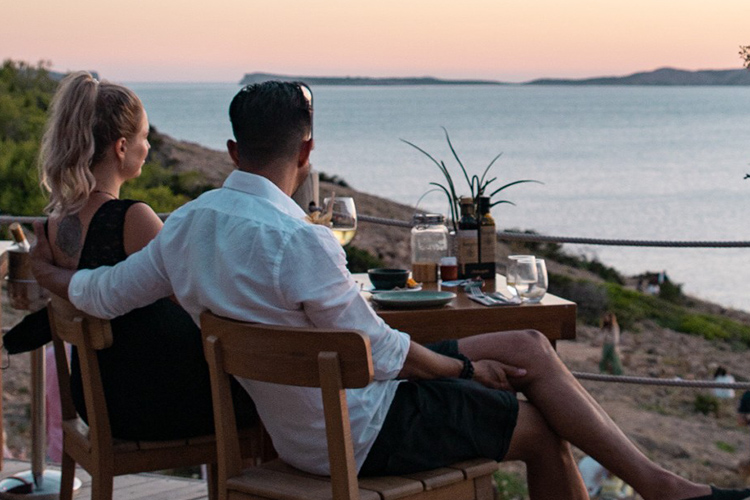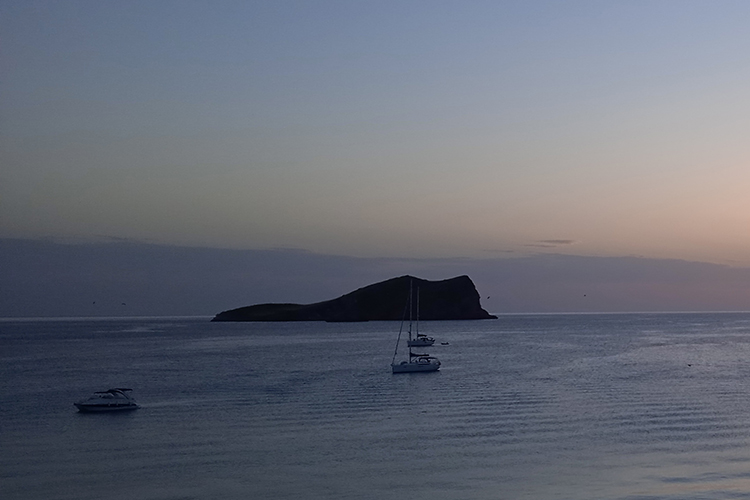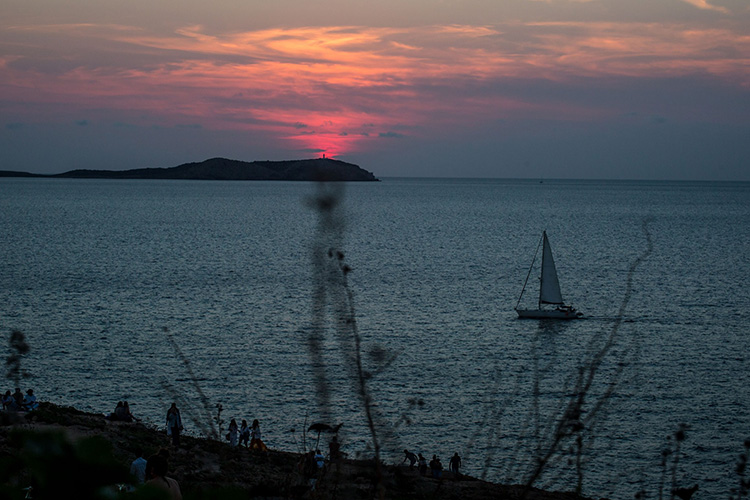Interesting facts about Sa Conillera and s’illa des Bosc, the islets seen from Hostal La Torre
The islets of Sa Conillera and s’illa des Bosc are part of the Nature Reserves of Es Vedrà, Es Vedranell and the islets of Ponent, a protected sea-land nature area on the western coast of Ibiza and included in the Natura 2000 network, so it’s also protected as an SPA (Special Protection Area) for birds. These islets are divided into two groups: one made up of Es Vedrà and Es Vedranell; and the other made up of the islets of Poniente, which include Sa Conillera, Illa des Bosc, s’Espartar and Ses Bledes (which in turn groups Na Gorra, Es Vaixell, Na Bosc, els Esculls d’en Ramon and Na Plana).
 The islets of Sa Conillera and s'illes des Bosc give a unique beauty to our sunset. © Hostal La Torre
The islets of Sa Conillera and s'illes des Bosc give a unique beauty to our sunset. © Hostal La Torre
interesting facts about Sa Conillera islet
- This islet is the first to appear on our hotel backdrop with its lighthouse flashing on the horizon the moment the sun starts to dip behind the sea.
- The island measures nearly 100 hectares and is two kilometres long, from north to south.
- Its name, Conillera in Catalan and Conejera in Spanish, is not because of its rabbits (conejera is a rabbit hole in Spanish). It owes its name to the countless caves and underwater cavities in the islet, so it’s possible it’s a reference to their similarity with burrows.
- This islet is home to wall lizards Podarcis pityusensis cunicularia, the Peregrine falcon (Falco peregrinus), the European storm petrel (Hydrobates pelagicus) and the Audouin’s gull (Larus audouinii), among other species.
- Several Phoenician-Punic shipwrecks were found on its seabed, as well as Roman amphorae.
- Legend has it that the famous Charthaginian general, Hannibal, was born in the so-called Casa de n’Annibal house, on the highest spot in the south of the island.
 Sa Conillera islet at sunset. © Hostal La Torre
Sa Conillera islet at sunset. © Hostal La Torre
- Its lighthouse was built in 1857 and the lighthouse keepers and their families lived in the houses next to it until 1971, when the lighthouse became automated and no longer needed a keeper. Nowadays, it flashes its white light four times every twenty seconds and can be seen as far as 18 nautical miles away.
- Sa Conillera is private property and due to its environmental protection can only be accessed for research purposes with a special permit from the regional environmental authorities (Conselleria de Medi Ambient).
- Every year, the Institut Balear de la Natura organises the occasional informative visit. If you’d like to visit the island during your stay at Hostal La Torre, ask our front desk and we’ll confirm if there are any visits planned for those dates.
- A few years ago, an archaeological dig revealed the existence of 16th century graves and they found skeletons with traces of sword cuts and other violent injuries that were probably caused by Berber pirates.
- If you like diving, you can hire this service with specialised companies, like Arenal Diving, and ask to go diving around Sa Conillera.
 Sa Conillera and its lighthouse. © farsdebalears.com
Sa Conillera and its lighthouse. © farsdebalears.com
interesting facts about s’illa des bosc islet
- There are no trees there nowadays, but the name s'Illa des Bosc comes from a time when it was covered in pine trees and juniper trees. The timber industry depleted the island of trees so now it’s mostly covered in shrubbery.
- Hostal La Torre offers a view of its tallest outline, whereas Cala Comte looks out onto its southern side with a gentle drop to the see.
- The small Na Bosc islet (one of the other islets of the Nature Reserves of Es Vedrà, Es Vedranell and the islets of Ponent) shares its name with Illa des Bosc given their resemblance.
- Four rocks stand proudly between the beach of Cala Conta and the southern coastline of s'Illa des Bosc, making it hard to sail through if you don’t have a small boat. In fact, larger boats need to go all the way round s’Illa des Bosc.
 The islet of s'ille des Bosc, to the left of the image, is also visible from our terrace. © Hostal La Torre
The islet of s'ille des Bosc, to the left of the image, is also visible from our terrace. © Hostal La Torre
interesting facts about s’Espartar islet
Except for two peaks, s’Espartar hides behind the outline of s’Illa des Bosc, but this won’t put us off learning about its interesting facts, right? If you want to get a full view of it, you’ll have to take a look from Platges de Comte.
- Its name comes from the vast amount of esparto on the island. This perennial halfah grass is found all over the Pitiusa islands, but is especially abundant in s’Espartar.
- Man has been working with esparto for thousands of years given the strength and malleability of its leaves after processing them.
- Ibizan peasants would pick the necessary esparto from the islet to make ropes, baskets and espadrilles, among other things.
- S’Espartar, as well Sa Conillera, is part of the Nature Reserves of Es Vedrà, Es Vedranell and the islets of Poniente, so you can’t set foot on it without a special permit.
- July and August were the months when the peasants would go to the islet to gather esparto and then prepare it to be used. They would first leave it to dry, then bag it and keep underwater in the sea for over a month and lastly, they would leave it to dry again.
- If you like diving, you will find octopuses, moray eels and common dentex around the islet.
 S'Espartar from Platges de Comte. © NC/Hostal La Torre
S'Espartar from Platges de Comte. © NC/Hostal La Torre
sunset with a view of the islets
Hostal La Torre opens 365 days a year, so our terrace get to see the sun set all four seasons. Whenever we can, we remind our friends and guests that you get the most spectacular sunsets in Ibiza the winter, as the air is clean of humidity and the high clouds dye the sky different hues of red. And, during those months, we get the chance to watch the sun set just between the islets of Sa Conillera and s’illes des Bosc from our terrace.
But don’t think you’ll be missing out in the summer: far from it! From spring to early autumn, sunset is our favourite time of the day, as the atmosphere is full of magic, great music with the best Balearic Sound and all the intensity of the sunset with the sea and islets of Sa Conillera and s’illa des Bosc in the background. Something special to experience with someone special. Who will you be coming with?
 The sunset, Sa Conillera and s'illes des Bosc wait for your at Hostal La Torre. © Grupo Mambo
The sunset, Sa Conillera and s'illes des Bosc wait for your at Hostal La Torre. © Grupo Mambo
Main picture: © Alba Haut / Hostal La Torre





